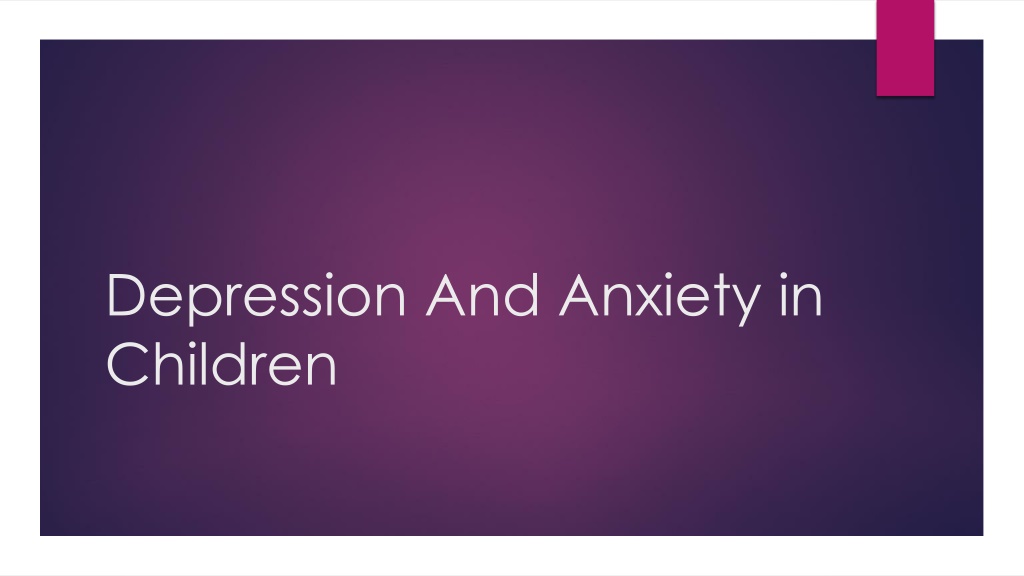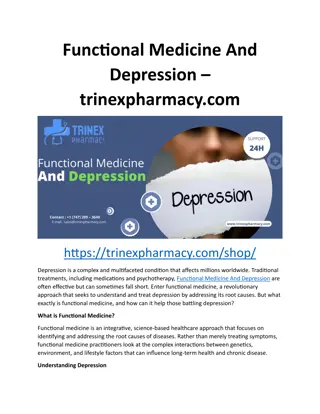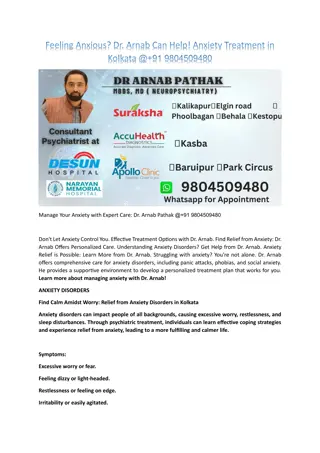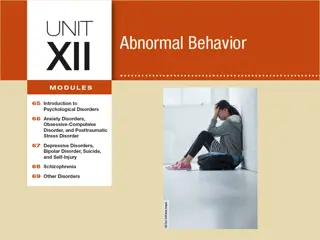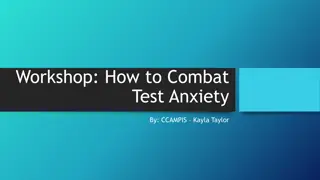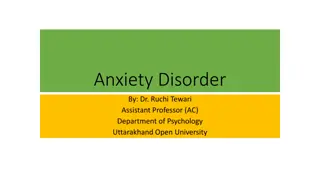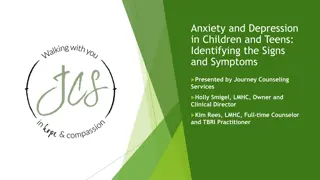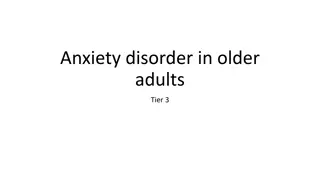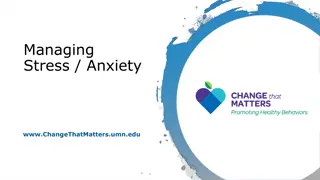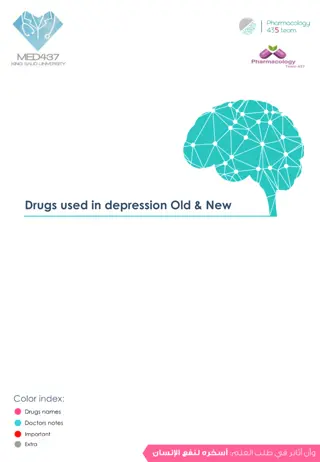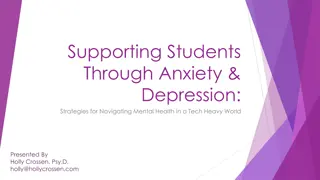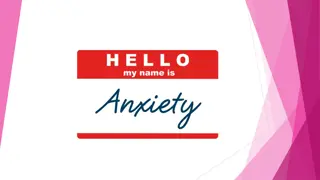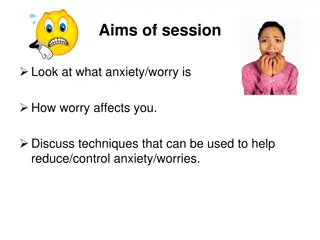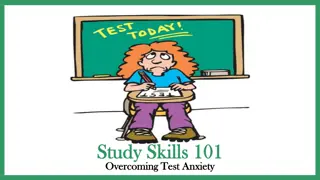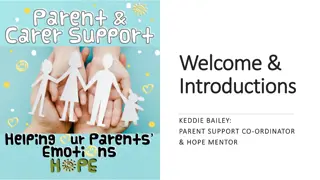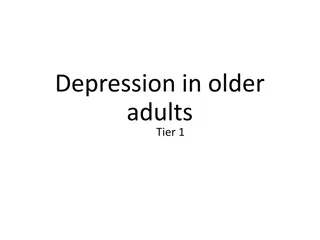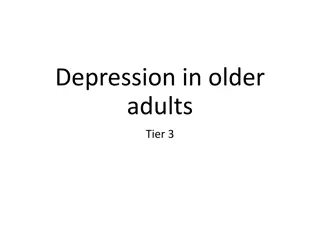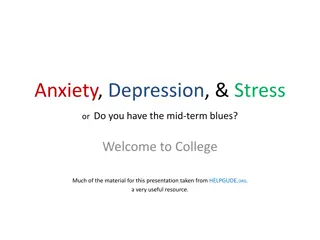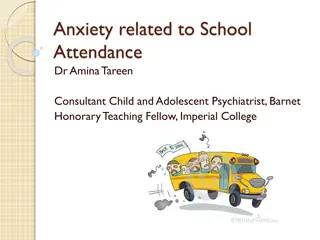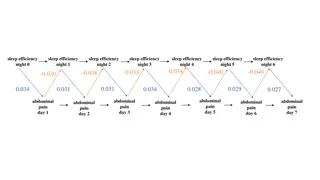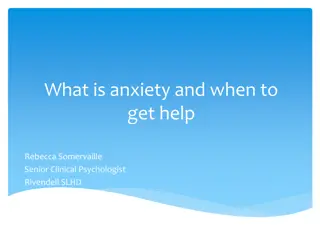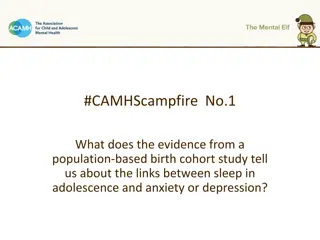Depression and Anxiety in Children
Depression and anxiety in children are serious mental health concerns that can impact their daily functioning and overall well-being. Childhood depression, if left untreated, can lead to long-term consequences. Recognizing the signs and symptoms of depression in children, such as irritability, social withdrawal, and changes in appetite or sleep patterns, is crucial for early intervention. Various factors, including biological, genetic, and psychosocial influences, can contribute to depression in children. Teachers and school staff play a vital role in identifying warning signs and supporting children who may be experiencing depression.
Download Presentation

Please find below an Image/Link to download the presentation.
The content on the website is provided AS IS for your information and personal use only. It may not be sold, licensed, or shared on other websites without obtaining consent from the author.If you encounter any issues during the download, it is possible that the publisher has removed the file from their server.
You are allowed to download the files provided on this website for personal or commercial use, subject to the condition that they are used lawfully. All files are the property of their respective owners.
The content on the website is provided AS IS for your information and personal use only. It may not be sold, licensed, or shared on other websites without obtaining consent from the author.
E N D
Presentation Transcript
Depression And Anxiety in Children
What is Depression? Depression is a mental illness in which a person has persistent feelings of sadness, irritability, loneliness, hopelessness, and guilt. It is a mental health disorder that can be successfully treated.
Childhood Depression Occurs when the feelings of depression persist and interfere with a child or adolescent's ability to function.
Childhood Depression Is different than the normal "blues" and everyday emotions that occur as a child develops 5% of children and adolescents suffer from depression at any given point in time.
Childhood Depression Many children with depression can go undiagnosed. A child's depressed mood may be evidenced by acting out behavior (this occurs more frequently in younger children). They may yell, scream, be defiant, use foul language and throw temper tantrums. They are sometimes misdiagnosed as having ADHD. Children under stress, who experience loss, or who have learning, conduct or anxiety disorders are at a higher risk for depression.
What causes depression in children? There is no one cause of depression Depression can be caused by a biochemical imbalance in the brain. It can be triggered by a traumatic event. Research suggests that there is a complex interplay between biological, genetic, and psychosocial factors (distressing life events) that lead to depression. Depression tends to run in families.
As teachers and school staff we see students every day and can observe the warning signs of depression.
Depression in Children: Signs and Symptoms -Irritability or anger -Excessive sadness, crying, and/ or whining -Feelings of hopelessness(can manifest as negative self-talk) -Feelings of worthlessness (kids may feel worthless, unloved or stupid) -Social withdrawal withdrawal from friends and activities -Increased sensitivity to rejection -Major changes in appetite either increased or decreased -Changes in sleep sleeplessness or excessive sleep -Vocal outbursts
Depression in Children: Signs and Symptoms -Excessive guilt -Difficulty concentrating -Fatigue or low energy too tired to play -Academic decline because of not participating, paying attention, or completing school work -Feeling miserable most of the time regardless of the activity -Children may hide or sequester themselves to avoid family and social interactions -Frequent physical complaints such as headaches and stomachaches -Giving away beloved toys or possessions -Thoughts of death or suicide
Other "Red Flags" Play that involves excessive aggression toward oneself or others Play that involves persistent sad themes With depression the behaviors will last more than two weeks more than a temporary slump!
Suicidal thoughts and ideations should be taken seriously Talk about wanting to die Drawings or behaviors involving the student dying or his or her death Although relatively rare in children under 12, young children do attempt suicide and may do so impulsively when they are upset or angry. Girls are more likely to attempt suicide but boys are more likely to actually kill themselves when they make an attempt.
What can we do at school: Recognize the signs Consult with school social worker or school psychologist Listen when our students share information about their feelings Provide unconditional support be there for them Help student implement coping strategies Help student by highlighting positive skills and interests Help family monitor symptoms Be hyper-vigilante and report changes you notice to parent/guardian With signed consent, communicate with child's doctor or therapist
Good news depression can be treated Referral to pediatrician for evaluation of symptoms Referral to mental health provider for counseling Children with depression benefit from individual therapy Child may also benefit from family therapy Child's doctor may recommend medication
Watch this video about the signs of childhood depression. http://www.youtube.com/watch?v=qkUym5G wqQs
Anxiety Disorders Anxiety is a normal human emotion that everyone experiences at times. Anxiety is the emotion that protects people in fight or flight situations. When anxiety is prolonged or occurs at other times, it is an anxiety disorder. Anxiety disorders are serious mental disturbances. For people with anxiety disorders, worry and fear are constant and overwhelming. The anxiety is so severe that it interferes significantly with occupational and educational functioning, social activities and close relationships. Anxiety disorders may develop from a complex set of risk factors, including genetics, brain chemistry, personality and life events. There are often physical symptoms that occur along side anxiety disorders. Some symptoms may include, heart palpitations, sweating, faintness, stomachaches, difficulty sleeping and irritability. It is estimated that 40 million adult Americans suffer from anxiety disorders. 13% of children and adolescents are affected by anxiety disorders each year. Anxiety disorders are highly treatable with therapy and/or medication. The Diagnostic and Statistical Manual of Mental Disorders (DSM-IV) has several different categories of anxiety disorders.
Anxiety Disorders Generalized Anxiety Disorder Social Anxiety Obsessive-Compulsive Disorder Panic Disorder Post Traumatic Stress Disorder Separation Anxiety
How to help children experiencing anxiety in school Be reassuring of their safety (just remember that lots of positive attention to anxious behavior reinforces the anxiety). Connect with a safe person at school (Refer to school social worker or psychologist). Gradually expose the child to the situation (take 1 step at a time). Provide social skills development so children can learn to cope. They need to learn that they will be okay they can do it. Increase child s assertiveness skills so they can learn to ask for what they need stick up for themselves. Teach these children relaxation/self soothing techniques. Teach these children to self talk. Boost their self esteem/confidence (have them identify strengths). Provide support to parents during this stressful time. School social worker may refer student for outside mental health counseling (outside of school, a parent may wish to have their child participate in Cognitive Behavioral Therapy, family therapy or try medication). *Separation Anxiety is usually temporary and part of normal development (children figuring out the world around them)
Anxiety in children is treatable Referral to therapist for Individual therapy and/or famliy therapy Cognitive behavioral therapy Biofeedback/neurofeedback Teaching self-soothing strategies Referral to pediatrician or psychiatrist for medication
